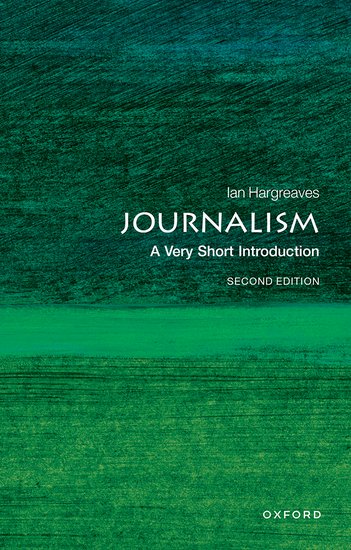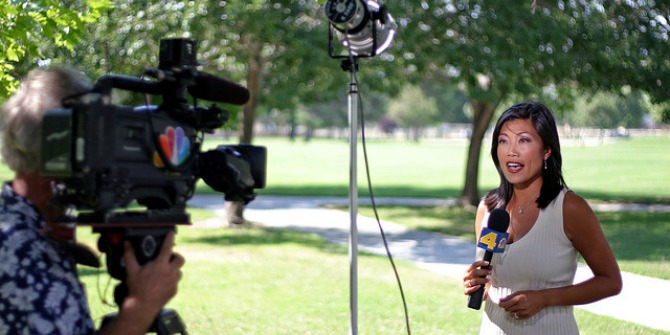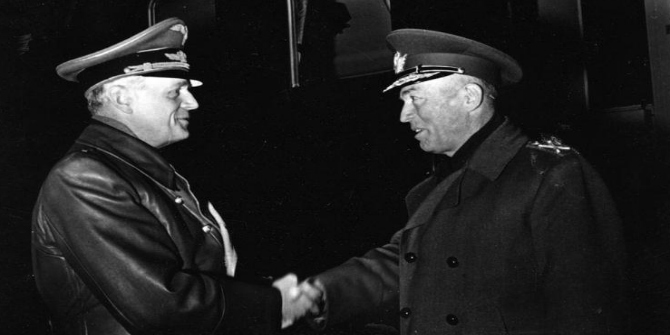In a world where many consumers are unhappy to pay for news and entertainment content, what is the future of journalism? In this Very Short Introduction, Ian Hargreaves looks not only at what journalism has been in the past, but also at what it is becoming in the digital age, and examines the big issues relating to reportage, warfare, celebrity culture, privacy, and technology worldwide. Recommended by Fiona Chesterton.
 Journalism: A Very Short Introduction. Ian Hargreaves. Oxford University Press. 2014.
Journalism: A Very Short Introduction. Ian Hargreaves. Oxford University Press. 2014.
Putting a study of Journalism next to one on Fossils and another on the Crusades would be something that a bookseller might hesitate to do, but the first edition of this Very Short Introduction (or VSI) was so placed in the astonishingly eclectic series that the Oxford University Press has been putting together for the past twenty years. Now as the OUP series passes the 400 mark, this second edition is surely justified by the transformational decade that the journalism industry has gone through.
The author Ian Hargreaves’ own career in many ways mirrors the odyssey of the industry. Now holding the title of Professor of the Digital Economy at Cardiff University, he started out the traditional way on local newspapers in Yorkshire. His career has also spanned editing national papers as well as being Director of News in the Birt era at the BBC and in more recent years at media regulator OFCOM.
Well, where does one start in a short guide to Journalism? With a definition? So how about a pillar of democracy? Or a grubby and somewhat disreputable trade? (The latter being closer to the popular view).
Professor Hargreaves’ definition goes for the noble end of the spectrum of possibilities: ‘Journalism’s job is to hold all power to account and to provide the resources of information and opinion upon which democracy thrives’. Then of course there was the grittier definition attributed to Lord Northcliffe: ‘News is something that someone somewhere doesn’t want printed. All the rest is advertising.’ As the VSIs have been described by one critic as the Thinking Man’s Wikipedia – snooty reference as that is to what is a prime example of a transformational product of the Internet age that Hargreaves describes – I thought I would sample their definition, which is more prosaic but broader.
‘Journalism is gathering, processing and dissemination of news, and information related to the news, to an audience. The word applies to both the method of inquiring for news and the literary style which is used to disseminate it… In modern society the news media is the chief purveyor of information and opinion about public affairs. Journalism however is not always confined to the news media… as journalistic communication may find its ways into broader forms of expression, including literature and cinema.’
Hargreaves’ high-minded definition does enable him to find a way to focus and give a theme to his pocket-sized volume, but it does mean that some areas of journalistic endeavour – for example reviews, lifestyle (all that cookery and property!) and sports coverage – are given no space. Indeed, I detect a lack of interest in much of the so-called tabloid i.e. popular agenda. Of course, few would argue that the most important purpose of journalism is to act as a forum within democratic societies, but there’s much entertainment to be had from journalism as well – and maybe Professor Hargreaves could have written a livelier volume if he had recognised that more.

After all, the VSI mission according to the OUP is to provide ‘stimulating ways into new subjects’ for readers. The budding journalism student should also be warned that this volume is absolutely not a ‘how-to’ book. It gives no tips to budding reporters or editors. Indeed, there is much that might deter aspirant journalists. Hargreaves’ first illustration is entitled ‘The Ten Deadliest Countries for Journalists’. This list is a sobering one, as it shows that not just the familiar Middle East war zones feature, but also countries like Russia and India. He also points to UK statistics suggesting that even where the practice of journalism is safer, it is by no means financially secure. He quotes 2012 UK statistics showing that nearly a third of journalists were self-employed and that pay had fallen 12 per cent in real terms in a decade.
For the general reader though, who wants an intelligent tour of the journalistic horizon, there is much in Hargreaves’ book to stimulate. The chapter “Hacks v Flaks”, about the relationship between Journalism and Public Relations – both commercial and political is a great example. His account of the extraordinary media revolution since the turn of the millennium is particularly incisive. Hargreaves describes the changing economics of the industry, which has seen new media behemoths arise. Illustrations which tell a thousand words include Jeff Bezos, founder of Amazon, purchasing the Washington Post a few chapters after titan Rupert Murdoch is shown launching the News of the World – to be shamed and closed in 2011. The author also reminds us constantly of the interplay between journalism and democracy. So there is time in the narrative for radical players (who might not even describe themselves primarily as journalists) like Julian Assange. The role of Al Jazeera and social media in the Arab Spring is also referenced.
Throughout, Hargreaves tells a global story, though, maybe inevitably, the core narrative focuses on journalism in the United States and the UK. Another telling graphic shows a world map with a full two thirds of the planet not yet enjoying a free or even partly free press.
No doubt that struggle for free expression will continue to rage. How journalism will develop in modern China (a country which Hargreaves suggests, rather than Gutenberg’s Germany, saw the first news sheets ‘tipao’ a millennium ago). And what of India? As well as featuring in that top ten list of dangerous places for journalists, it has also gone against the media tide and seen a huge growth of newspaper circulations in recent years as literacy increases.
Ultimately, Hargreaves’ book has a positive underlying message. Newspapers may come or go, media moguls may rise and fall, tyrants and repressive regimes may oppress for a time, but beyond all that, journalism will survive and even thrive because it meets a basic human aspiration.
Fiona Chesterton worked as a Producer, Editor, and Commissioning Editor at the BBC and at Channel 4, primarily in News and Current Affairs. She was made a Fellow of the Royal Television Society in 2008. Read more reviews by Fiona.







